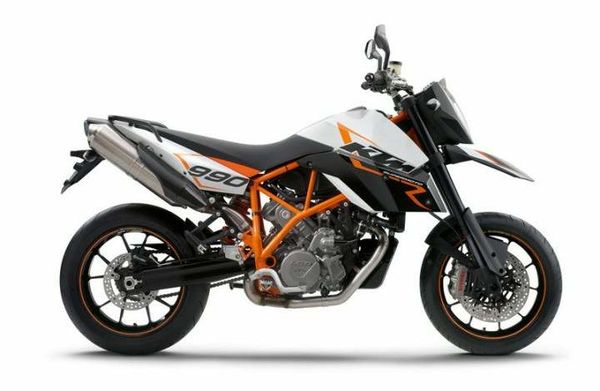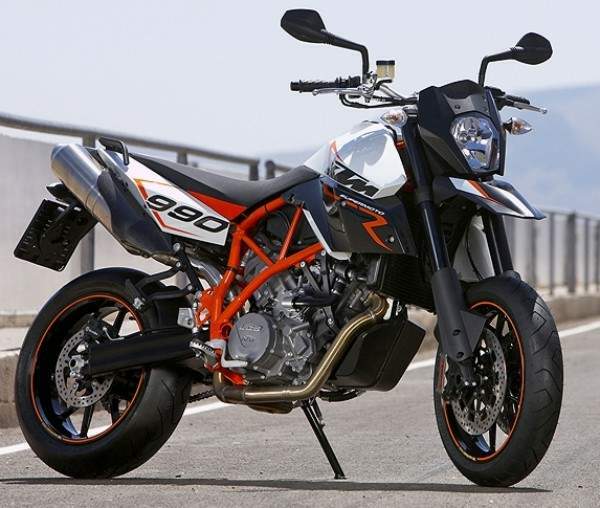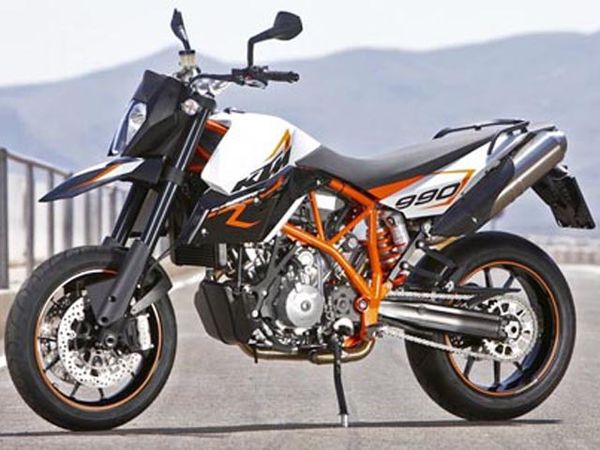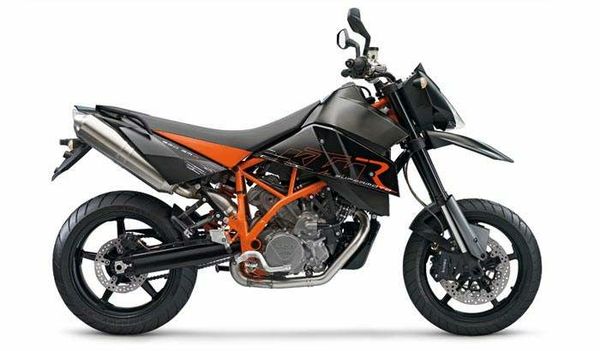KTM 990 Supermoto R
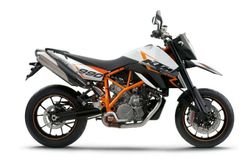 |
|
| KTM Supermoto 990 | |
| Manufacturer | |
|---|---|
| Also called | 990 Supermoto, 990 Supermoto R, 990 Supermoto T |
| Production | 2008 |
| Engine | Four stroke, 75°V-twin cylinder, DOHC, 4 valves per cylinder |
| Compression ratio | 11.5:1 |
| Top Speed | 229.8 km/h |
| Ignition | Contactless, controlled, fully electronic ignition system with digital ignition timing adjustment |
| Battery | 12 V/11.2 Ah |
| Transmission | 6 Speed |
| Frame | Tubular space frame made from chrome molybdenum steel, powder-coated |
| Suspension | Front: 48mm WP USD adjustable Rear: WP shock, fully adjustable |
| Brakes | Front: 2x 305mm discs 4 piston calipers Rear: Single 240mm disc 2 piston caliper |
| Front Tire | 120/70 ZR17 |
| Rear Tire | 180/55 ZR17 |
| Wheelbase | 1505 mm / 59.3 in |
| Seat Height | 875 mm / 34.45 in |
| Weight | 192 kg / 423 lbs (dry), |
| Fuel Capacity | 15 Liters / 3.9 gal |
| Manuals | Service Manual |
It could reach a top speed of 229.8 km/h.
Engine[edit | edit source]
The engine was a Liquid cooling, cooled Four stroke, 75°V-twin cylinder, DOHC, 4 valves per cylinder. The engine featured a 11.5:1 compression ratio.
Drive[edit | edit source]
Power was moderated via the Wet multi-disc clutch, operated hydraulically.
Chassis[edit | edit source]
It came with a 120/70 ZR17 front tire and a 180/55 ZR17 rear tire. Stopping was achieved via 2x 305mm discs 4 piston calipers in the front and a Single 240mm disc 2 piston caliper in the rear. The front suspension was a 48mm WP USD adjustable while the rear was equipped with a WP shock, fully adjustable. The 990 Supermoto R was fitted with a 15 Liters / 3.9 gal fuel tank. The bike weighed just 192 kg / 423 lbs. The wheelbase was 1505 mm / 59.3 in long.
Photos[edit | edit source]
Overview[edit | edit source]
KTM 990 Supermoto R
An evolution of the Supermoto 950, the Supermoto 990 R gets the Super Duke Rs 999cc LC8 engine, Brembo brakes with monoblock radial-mount calipers, fully adjustable suspension front and rear, bigger fuel tank.
Compared to the standard model, The new "R" is immediately recognizable to a new color scheme, as the Enduro 690 R, identifies the versions of the sport ever wider range of Austria.
Trellis frame tube orange, double-arm swingarm in a graphic novel burnished, slightly sfiancato tank and suspensions utraregolabili complete a technical picture that is not missing anything, from lightweight alloy wheels to get to the radial Brembo calipers.
The engine, a V-twin of 75 degrees, provides as the standard 115 hp to 9,000 and a pair of 97 Nm at 7000 rpm, while in terms of weight the introduction of new elements has led to a weight saving of approximately 1 kg for a total of 190 kg.
Review This is Part One of a two-part report on our recent test of new KTM bikes for the U.S. Is a supermoto-a dirtbike with roadrace tires and brakes-the ultimate motorcycle? If you worked all day in a giant orange shed, youd think so. Its our heritage, said KTM P.R. Manager Thomas Kuttruff, referring to KTMs 20 years in the supermoto business. Of course, riding around on a frantic, short-geared thumper can be limiting, so adding a second cylinder to a supermoto makes a versatile, fun and reliable bike you can ride every day, even for long highway stints. KTM first treated the world to big supermotos with the 950 SM, which it upgraded to a 990 a few years ago, adding fuel-injection and some more ponies. You may think the Supermoto is just a Superduke 990 with less bodywork and more suspension travel, but youd be wrong. The Supermoto, Superduke and RC8 Superbikes all have different motors: the 990 Supermoto and 990 Adventure share the most dirt-oriented motors, with a single-shaft counterbalancer as opposed to the Superbikes dual gear-driven balancers. The frame and suspension is different too.
Americans get two versions of the big supermoto, the sporty R and a more practical tourer. Both bikes share a liquid-cooled, fuel-injected, four-valve 75-degree 115-hp motor and basic chrome-moly trellis chassis. From that common ancestor, KTMs engineers started adding go-fast bits to make the R. Wheels are forged Marchesinis, saving 4.4 pounds of rotating mass, and it gets those delicious four-piston Brembo monobloc racing calipers. A supermoto needs a powerful, sensitive rear stopper as well: the R (and T) is equipped with a two-piston caliper back there. The minimal plastic bodywork is deceptive: the low-profile tank holds almost four gallons. The T is a little more staid, but not much. It gets cast, two-piece calipers, softer suspension (but still fully adjustable), a larger 5-gallon tank, a windscreen and easily detachable semi-hard luggage. Theres also a larger, more passenger-friendly saddle and a luggage rack. Wheels are a little heavier than the Rs, and the fork doesnt get the fancy black TiAn coating. That all means the T is 432 pounds without fuel, compared to the Rs 417-pound claimed weight, but both bikes are priced the same at $13,998.
Since the KTM 2010 model intro I attended was mostly a racetrack event, there was only a brief street ride to evaluate the T, but there were a few Rs available for track evaluation. No matter: riding the R on the track may have been the most fun I had all day. Sure, its heavier and (a lot) slower than the RC8 R, but its wide, flat, high handlebar and torquey motor made it big fun to snap in and out of turns, and the bikes balanced nature and slim form made it feel a lot lighter than it was. No need to move my rapidly disintegrating body around so much: just roar up to the apex, snap it in, power out, repeat. Out on a brief street ride, the R inhaled the twisty Laureles Grade, with more-than-ample power and that same grippy, tenacious feel it exhibited on the track. Riding a supermoto with this kind of power, brakes and excellent suspension doesnt really feel like a fair fight. If I had one, Id probably have to make new friends. Power is snappy, with the same excellent fuel-injection and part-throttle response the RC8 R showed (featured in Part Two later this week), and the gearing felt about right for fast roadwork. The motor is more raw and buzzy than the silky, quick-revving RC8 mill, but if youre used to a thumper dual-sport, its not objectionable. But a touring rig its not: the narrow, hard seat became noticeable after about 30 minutes of riding, and wind protection is zero. Think of the SM R as your basic inner city commuting/Sunday backroads thrasher. For something almost as fun and much more practical, the SM T should work much better. The seat is more seat-like and the windscreen and handguards offer some useful wind protection. The seating position keeps the ol knees from bending too much, and the bars are high. The bags, while small, are unobtrusive (making for easy lane-splitting) and easy to remove or attach. The larger bags for the 990 Adventure can be fitted, although that would require new brackets. The main difference between the T and the R-as long as youre not working the brakes too hard-is the softer suspension. The T exhibits the same neutral, easy steering, except with a plusher ride. And plush doesnt just mean soft. Theres actual controlled damping, and the three-way (compression, rebound and spring preload) adjustable WP components (with adjustments that actually do something) should let the rider fine-tune the ride to perfection. It tracks through corners, keeping the wheels on the ground, and bumps and potholes dont jar your spine the way some European bikes would. I loved scraping up my brand-new Dainese kneepucks in Lagunas fabled turns on the RC8s, but street riding is satisfying because you can do it all day long and the variety of roads is endless. What heightens that experience is having a bike that handles like a well-set-up racebike in the twisties but is comfortable to ride on the boring stretches in between. The 990 SM T is one of those bikes, a real do-it-all machine with tremendous character, performance and reliability. One bike I didnt get to ride, which makes its debut in both the USA and Europe, is the 2010 690 Duke R. Its based on the excellent , a single-cylinder supermoto thats designed to be a fun and reliable streetbike. The R version takes the 65-hp, 654cc liquid-cooled Single from the standard 690 and (heh, heh) pumps it up to 70 hp with more compression and another 45cc: its an actual 690. The motor goes into an orange-painted trellis frame, suspended by upgraded front and rear components. A pound is shaved off the 690s 327-pound tank-dry weight with some carbon pieces. Ive ridden the 690 Duke, and found that bike to be as light, good-handling and torquey as youd guess: a 65-hp Single used to be the realm of cooped-up Scandinavian winter tinkerers, but now anybody can buy one of these for $10,998, just $500 more than the standard 690 Duke. Adding the T and R to the lineup gives KTM USA a full range of large-displacement streetbikes, unimaginable a decade ago. Theyre priced out of the market the Japanese bikes swim in, but are affordable compared to competition from BMW, Ducati and Aprilia. 2010 will be a great year for superbike and supermoto comparison tests.
Source
| Make Model | KTM 990 Supermoto R |
|---|---|
| Year | 2008 |
| Engine Type | Four stroke, 75°V-twin cylinder, DOHC, 4 valves per cylinder |
| Displacement | 999.8 cc / 60.9 cu-in |
| Bore X Stroke | 101 x 62.4mm |
| Cooling System | Liquid cooling, |
| Compression | 11.5:1 |
| Lubrication | Dry-sump lubrication with 2 rotor pumps |
| Exhaust | 2 x Premium steel with three-way-catalyser |
| Induction | Electronic fuel injection / electric |
| Ignition | Contactless, controlled, fully electronic ignition system with digital ignition timing adjustment |
| Battery | 12 V/11.2 Ah |
| Starting | Electric |
| Max Power | 114.hp 83.2 kW) @ 4000 rpm |
| Max Torque | 97.Nm / / 71.5 ft/lb @ 7000 rpm |
| Clutch | Wet multi-disc clutch, operated hydraulically |
| Transmission | 6 Speed |
| Final Drive | Chain. |
| Frame | Tubular space frame made from chrome molybdenum steel, powder-coated |
| Front Suspension | 48mm WP USD adjustable |
| Front Wheel Travel | 160 mm / 6.3 in |
| Rear Suspension | WP shock, fully adjustable |
| Rear Wheel Travel | 180 mm / 7.1 in |
| Front Brakes | 2x 305mm discs 4 piston calipers |
| Rear Brakes | Single 240mm disc 2 piston caliper |
| Front Tire | 120/70 ZR17 |
| Rear Tire | 180/55 ZR17 |
| Rake | 24.4° |
| Trail | 109 mm / 4.3 in |
| Wheelbase | 1505 mm / 59.3 in |
| Seat Height | 875 mm / 34.45 in |
| Ground Clearance | 195 mm / 7.7 in |
| Dry Weight | 192 kg / 423 lbs |
| Fuel Capacity | 15 Liters / 3.9 gal |
| Consumption Average | 17.2 km/lit |
| Standing ¼ Mile | 11.5 sec |
| Top Speed | 229.8 km/h |
